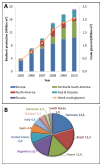Biodiesel biorefinery: opportunities and challenges for microbial production of fuels and chemicals from glycerol waste
- PMID: 22809320
- PMCID: PMC3467170
- DOI: 10.1186/1754-6834-5-48
Biodiesel biorefinery: opportunities and challenges for microbial production of fuels and chemicals from glycerol waste
Abstract
The considerable increase in biodiesel production worldwide in the last 5 years resulted in a stoichiometric increased coproduction of crude glycerol. As an excess of crude glycerol has been produced, its value on market was reduced and it is becoming a "waste-stream" instead of a valuable "coproduct". The development of biorefineries, i.e. production of chemicals and power integrated with conversion processes of biomass into biofuels, has been singled out as a way to achieve economically viable production chains, valorize residues and coproducts, and reduce industrial waste disposal. In this sense, several alternatives aimed at the use of crude glycerol to produce fuels and chemicals by microbial fermentation have been evaluated. This review summarizes different strategies employed to produce biofuels and chemicals (1,3-propanediol, 2,3-butanediol, ethanol, n-butanol, organic acids, polyols and others) by microbial fermentation of glycerol. Initially, the industrial use of each chemical is briefly presented; then we systematically summarize and discuss the different strategies to produce each chemical, including selection and genetic engineering of producers, and optimization of process conditions to improve yield and productivity. Finally, the impact of the developments obtained until now are placed in perspective and opportunities and challenges for using crude glycerol to the development of biodiesel-based biorefineries are considered. In conclusion, the microbial fermentation of glycerol represents a remarkable alternative to add value to the biodiesel production chain helping the development of biorefineries, which will allow this biofuel to be more competitive.
Figures



References
-
- Zhang Y-HP. What is vital (and not vital) to advance economically-competitive biofuels production. Process Biochem. 2011;46(11):2091–2110. doi: 10.1016/j.procbio.2011.08.005. - DOI
-
- O’Connor D. Commercializing Liquid Biofuels from Biomass. International Energy Agency (IEA), ; 2011. Report T39-T3. Biodiesel GHG emissions, pas, present, and future . A report to IEA Bioenergy Task 39. www.ieabioenergy.com/Liblinks.aspx.
-
- ANP. Agência Nacional do Petróleo, Gás natural e Biocombustíveis. Boletim mensal de biodiesel. 2011. Junho: http://www.anp.gov.br/?pg=59236&m=&t59231=&t59232=&t59233=&t59234=&ar=&p...
LinkOut - more resources
Full Text Sources
Other Literature Sources
Research Materials

